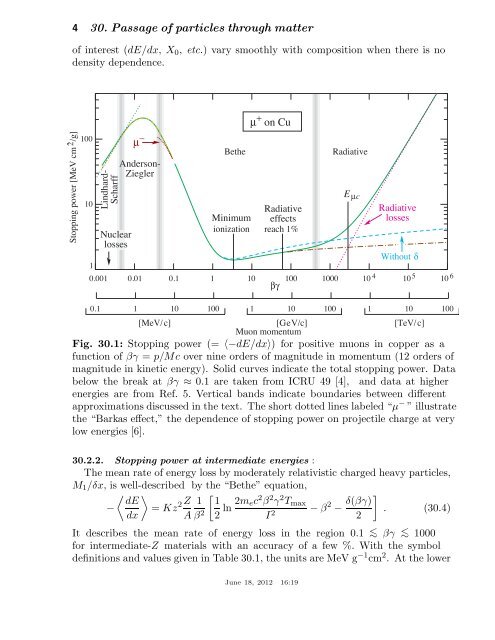30. Passage of particles through matter 1 - Particle Data Group
30. Passage of particles through matter 1 - Particle Data Group
30. Passage of particles through matter 1 - Particle Data Group
You also want an ePaper? Increase the reach of your titles
YUMPU automatically turns print PDFs into web optimized ePapers that Google loves.
4 <strong>30.</strong> <strong>Passage</strong> <strong>of</strong> <strong>particles</strong> <strong>through</strong> <strong>matter</strong><br />
<strong>of</strong> interest (dE/dx, X0, etc.) vary smoothly with composition when there is no<br />
density dependence.<br />
Fig. <strong>30.</strong>1: Stopping power (= 〈−dE/dx〉) for positive muons in copper as a<br />
function <strong>of</strong> βγ = p/Mc over nine orders <strong>of</strong> magnitude in momentum (12 orders <strong>of</strong><br />
magnitude in kinetic energy). Solid curves indicate the total stopping power. <strong>Data</strong><br />
below the break at βγ ≈ 0.1 are taken from ICRU 49 [4], and data at higher<br />
energies are from Ref. 5. Vertical bands indicate boundaries between different<br />
approximations discussed in the text. The short dotted lines labeled “µ − ” illustrate<br />
the “Barkas effect,” the dependence <strong>of</strong> stopping power on projectile charge at very<br />
low energies [6].<br />
<strong>30.</strong>2.2. Stopping power at intermediate energies :<br />
The mean rate <strong>of</strong> energy loss by moderately relativistic charged heavy <strong>particles</strong>,<br />
M1/δx, is well-described by the “Bethe” equation,<br />
� �<br />
dE<br />
− = Kz<br />
dx<br />
2Z 1<br />
A β2 �<br />
1<br />
2 ln 2mec2β2γ 2Tmax I2 − β 2 − δ(βγ)<br />
�<br />
2<br />
. (<strong>30.</strong>4)<br />
It describes the mean rate <strong>of</strong> energy loss in the region 0.1 < ∼ βγ < ∼ 1000<br />
for intermediate-Z materials with an accuracy <strong>of</strong> a few %. With the symbol<br />
definitions and values given in Table <strong>30.</strong>1, the units are MeV g −1 cm 2 . At the lower<br />
June 18, 2012 16:19







